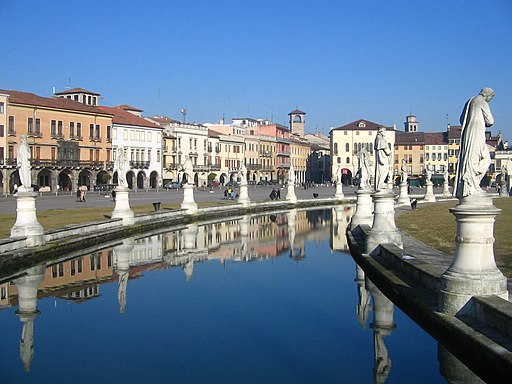
“Prà della Valle in Padua” by Canaletto depicts a public square in Padua, before an extensive makeover in 1775-1776 altered its appearance.
The painting represents a valuable record of the city’s history, and its grand piazza, with its large grassy surfaces, is bounded by the Basilica of Santa Giustina and by the University College.
The open square is shown with a multitude of people, plus several horsedrawn carriages and carts making the scene animated and alive.
The painting is an example of the style called the “Venetian veduta,” which is characterized by the integration of natural and architectural elements into a composition.
Canaletto was the master of the genre and one of its finest interpreters. Canaletto has created a vibrant painting with a brightness that permeates the scene while a multitude of shadows seems to dance with the figures and buildings.
Prato della Valle
The Prato della Valle ( Prà della Valle ) is the largest square in the city of Padua and among the largest in Europe. The current configuration dates back to the period of this painting.
It is characterized by a central elliptical island surrounded by a water channel on whose sides is a ring of statues.
There are currently 78 statues, and today’s layout derives from the destruction of six statues depicting Venetian doges demolished by the Napoleonic army in 1797.
Today’s View of the Prato della Valle
On the Prato della Valle faces the imposing abbey Basilica of Santa Giustina, first constructed in the 5th century, but its present form dates to the sixteenth century. Nearby is the monumental complex of the monastery.
The other churches around the square, shown in the painting, were demolished at the beginning of the nineteenth century.
Padua
Padua is the capital city of the province of Padua in northern Italy. The city is sometimes included, with Venice and Treviso, in the Padua-Treviso-Venice Metropolitan Area. Padua is 40 kilometers (25 miles) west of Venice.
It hosts the University of Padua, founded in 1222, where Galileo Galilei was a lecturer between 1592 and 1610.
Padua has played an essential role in the history of art with the university attracting many distinguished artists, such as Giotto, Fra Filippo Lippi, and Donatello.
The sculptor Antonio Canova produced his first work in Padua, one of which is among the statues that once stood at the Prato della Valle, but now is in the Musei Civici.
Padua is the setting for most of the action in Shakespeare’s The Taming of the Shrew, and there is a play by Oscar Wilde entitled The Duchess of Padua.
Facts about Padua
- First settled about 4th century BC
- Became part of Roman power in 215 BC
- Attila in 426 AD destroyed Padua
- Padua is home to the oldest Botanical Gardens in the World
- Padua is home to the second oldest university in Italy (1222)
- The city is where Saint Anthony, a Portuguese Franciscan (Anthony of Padua), spent part of his life and died in 1231.
- University where Galileo taught mathematics between 1592 and 1610
- Hieronymus Fabricius, a pioneering anatomist, and surgeon constructed the first Anatomical Theatre in 1594
Canaletto
Giovanni Antonio Canal (1697 – 1768), better known as Canaletto, who was born in Venice, is famous for his paintings of the city views of Venice, Rome, and London.
He was also a printmaker using the etching technique. From 1746 to 1756, he worked in England, where he painted the many sights of London.
He was highly successful in England, thanks to a British merchant, whose extensive collection of Canaletto’s works was sold to King George III in 1762, which significantly increased Canaletto’s prestige.
Prà della Valle in Padua
- Title: Prà della Valle in Padua
- Artist: Canaletto
- Year: 1741 – 1746
- Medium: Oil on canvas
- Dimensions Height: 39 mm (1.53 ″); Width: 87.50 mm (3.44 ″)
- Museum: Museo Poldi Pezzoli
Canaletto
- Artist: Giovanni Antonio Canal (Canaletto)
- Born: 1697 – Venice, Republic of Venice
- Died: 1768 (aged 70) – Venice, the Republic of Venice (now Italy)
- Nationality: Venetian
- Notable works:
- Bucentaur’s return to the pier by the Palazzo Ducale
- The Grand Canal in Venice
- The Entrance to the Grand Canal, Venice
- Piazza San Marco with the Basilica, Venice
- Santa Maria della Salute in Venedig vom Canal Grande
- A Regatta on the Grand Canal
- Prà della Valle in Padua
- “Capriccio: Ruins and Classic Buildings” by Canaletto
- Eton College
Padua City Tour
Explore the Museo Poldi Pezzoli
- “Portrait of a Girl” by Piero del Pollaiolo
- “Prà della Valle in Padua” by Canaletto
- “Capriccio: Ruins and Classic Buildings” by Canaletto
Explore Museums in Milan
- Santa Maria Delle Grazie
- Sforza Castle Museums
- Brera Art Gallery, Pinacoteca di Brera
- Museo Poldi Pezzoli
Explore Museums in Bologna
- The Archaeological Civic Museum (MCA) of Bologna
- Sanctuary of Santa Maria della Vita
Canaletto: A collection of paintings
Padua, Italy – Prato della Valle
~~~
“I come to wive it wealthily in Padua;
If wealthily, then happily in Padua.”
– Shakespeare in The Taming of the Shrew
~~~
Photo Credits: 1) Museo Poldi Pezzoli [Public domain] 2)No machine-readable author provided. P tasso assumed (based on copyright claims). [CC BY-SA 3.0 (http://creativecommons.org/licenses/by-sa/3.0/)]
Popular this Week








 Sponsor your Favorite Page
Sponsor your Favorite Page SEARCH Search for: Search Follow UsJoin – The JOM Membership Program
Sponsor a Masterpiece with YOUR NAME CHOICE for $5
Share this:
- Tweet

